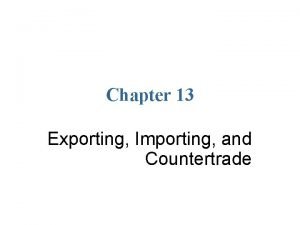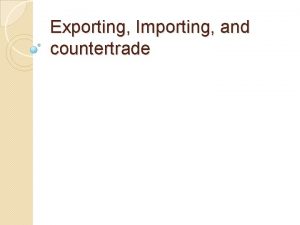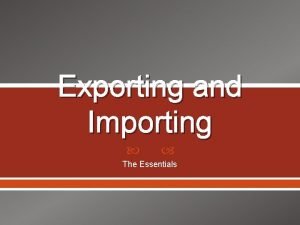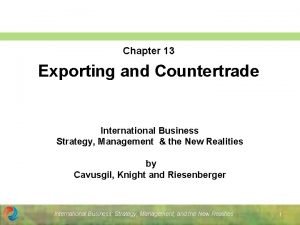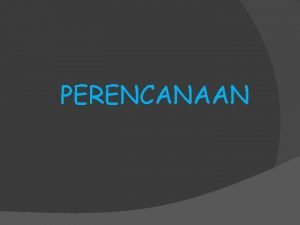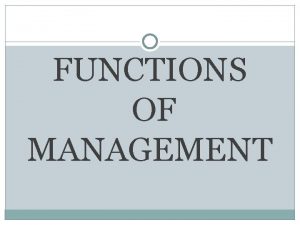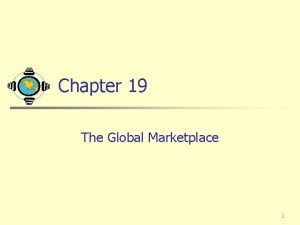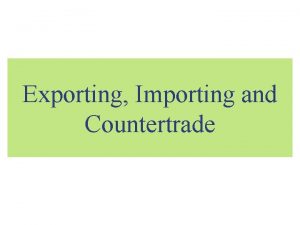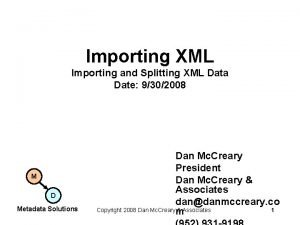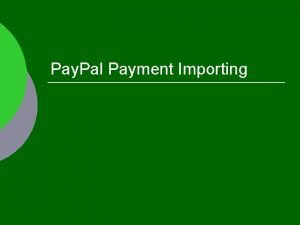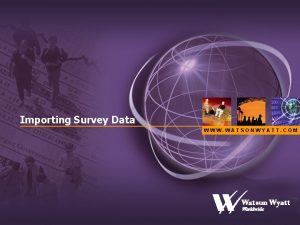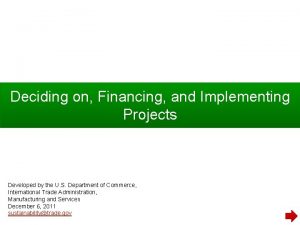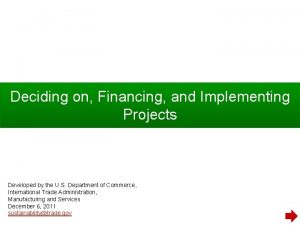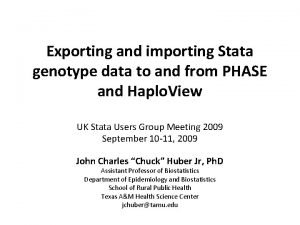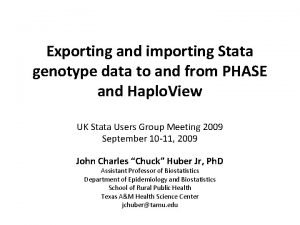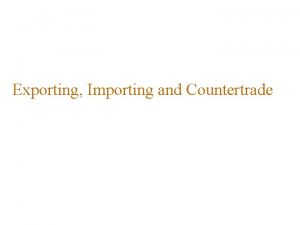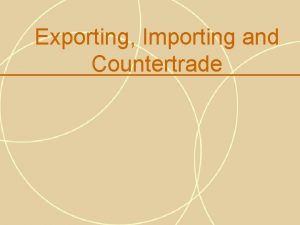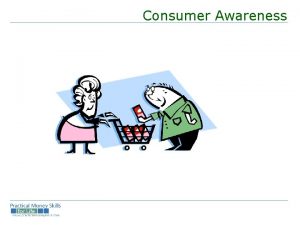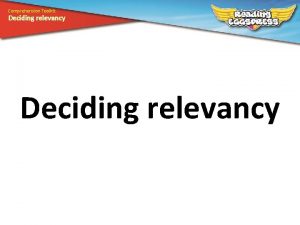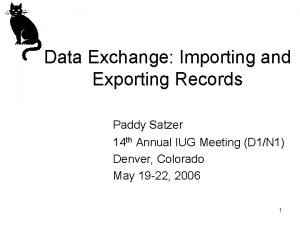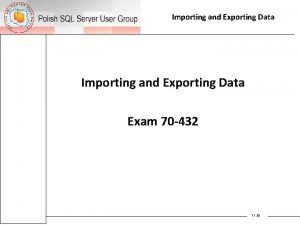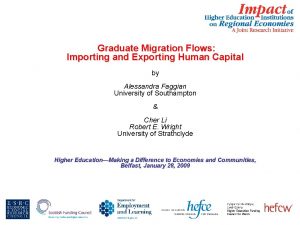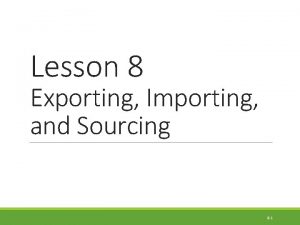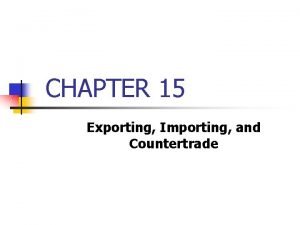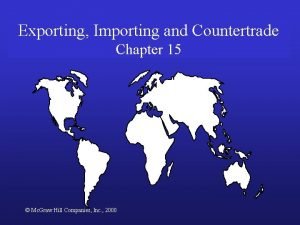Exporting and Importing The Essentials Exporting Deciding to











































- Slides: 43

Exporting and Importing The Essentials

Exporting

Deciding to Export Is the product exportable? o Legally exportable according to the Export Administration Regulations (EAR) • http: //www. bis. doc. gov/licensing/exportingbasics. htm o Easily imported into the targeted foreign market • Taxes (duties) or administrative expenses o Exempted from market-related restrictions • Unit size, nature of the product, modification costs o Possesses unique qualities • Competitive edge in new market (low cost vs differentiation) o Satisfies demand • AND can meet demand both in the domestic and international market o No existing prejudice against country of origin • US

Market Entry Options Three basic modes of entry for exporting 1. Stocking Distributors • Majority of export sales are done through distributors • Responsible for all aspects of marketing and distribution in the country importing the product • Purchase in stocking quantities and ship to customers from warehouse • http: //www. dcbattery. com/ 2. Piggybacking • • • 3. Seeking out and tying in with other non-competitive, complimentary product line exporters in your industry Learn from others – specifics of overseas distribution Establish relationships Export Management Companies (EMCs) • • Work on salary or retainer plus commission – solicits business Export Trading Companies (ETC) take title to goods and does the actual exporting

Follow Through with an Export Order You go to an expo and a prospect (Mr. X) later contacts you with an order inquiry and request for a quote o You – pro forma invoice = describe merchandise specifics, packaging, unit price, and payment terms. Mr. X – responds with a purchase order, including payment confirmation. o Mr. X arranges financing through bank o You begin production


Follow Through with an Export Order Mr. X (the importer) has bank verify company’s credit worthiness, prepare necessary documents, and informs you (through your bank) that all financial requirements have been satisfied. o You prepare goods for export and contact a freight forwarder to pick up shipment When the shipper receives goods – you are given a Bill of Lading (B/L) or air way-bill) = contains full description of shipment contents. o You prepare required documents (insurance policy, consular invoice, permits, etc) – these go to your bank who notifies Mr. X’s bank then sends payment to your bank o Meanwhile the goods are en route and Mr. X receives the transaction documents from your bank to claim goods on entry.

Export Administration Regulations BIS = Bureau of Industry and Security o Primary agency for implementing and enforcing EARs o EEA (Export Enforcement Arm of the BIS) protects • National Security • Foreign Policy • Economic Interests o Concerned with exporters, freight forwarders, carriers, consignees, and other involved parties o Intercepts illegal exports, investigates violations, and prosecutes violators of export control laws • BIS will negotiate settlements • VSDs – voluntary self-disclosure = violator admits to wrong doing

Export Control Reasons 1. National Security o Strategic commodities or technology 2. Foreign Policy o May be commodity oriented or country specific 3. Short Supply o To protect domestic economy from the excessive drain of scarce resources and reduce inflationary impact of foreign demand (petroleum products) Anti-Terrorism (AT), Missile Technologies (MT), Nuclear Proliferation (NP), Chemical and Biological Weapons (CB), Crime Control (CC), Regional Stability (RS), Computers (XP), UN Controls (UN)

EAR and Dual-Use Items Agencies in the EAR – http: //www. bis. doc. gov/licensing/index. htm#factsheets Dual-Use Items o Regulated by BIS o Commercial application but ALSO potential military or proliferation use (www. gpo. gov/bis/) • Weapons of extreme violence, conventional arms, or end-use violations by terrorists Regulations are complex o Freight forwarders used as resource

Foreign End-User Foreign end-user of US high tech products o VEU = Validated End User – legitimate exports to civilian end- user o Allows for export of eligible items to specified end-users in eligible locations without a license. • www. bis. doc. gov/finalchina. html - China VEU explanation

Competition and Transparency Keys to US recovery and security o Economic Competitiveness o Innovation Exporters need: o Sufficient information to support security and competitiveness goals o Transparency fosters awareness o Communication and participation with reforms Anti-boycott provisions o allow businesses to refuse participation in foreign boycotts o must report boycott-related requests

Export Licensing Any item sent from the US to a foreign destination is an export! Transfer (even if temporary) and Transaction (does not matter how it gets there) Small percentage of total US exports require an export license from the BIS Depends on technical characteristics, destination, end-user and end-use

What are you Exporting? ECCN = Export Control Classification Number o Alpha-numeric code identifying the level of export control o Listed in the Commerce Control List (CCL) o Commerce Country Charter (CCC) contains licensing requirements based on destination and Reasons for Controls o http: //www. bis. doc. gov/licensing/exportingbasics. htm Classifying is essential – you may submit a request to BIS o Determine which of the 10 categories of the CCL your included in o Then the five specific product groups your exports apply

Classification Commerce Control List Categories 0 = Nuclear materials, facilities and equipment (and miscellaneous items) 1 = Materials, Chemicals, Microorganisms and Toxins 2 = Materials Processing 3 = Electronics 4 = Computers 5 = Telecommunications and Information Security 6 = Sensors and Lasers 7 = Navigation and Avionics 8 = Marine 9 = Propulsion Systems, Space Vehicles, and Related Equipment Five Product Groups A. Systems, Equipment and Components B. Test, Inspection and Production Equipment C. Material D. Software E. Technology

Where are your Exports Going? OFAC = Office of Foreign Assets Control o in Treasury Department o Administers and enforces economic and trade sanctions o Acts under presidential wartime and national emergency powers or under authority granted by specific legislation Embargoed countries have most restrictions o Cuba, Iran, Sudan, Taliban controlled Afghanistan, Syria If sanctions are international – require cooperation with allied governments

Where are your Exports Going? Trade sanctions o could be revocation of preferential treatment such as Most Favored Nation (MFN) status or barriers against a country not abiding by agreed international rules of trade. Economic sanctions are disciplinary in nature and meant to isolate the target. o Economic sanctions may include trade embargoes or boycotts, freezing of assets, bans on cash transfers, bans on technology transfer and restrictions on travel. o Embargo – disposition of the state (between countries) o Boycott – private non-state initiative

Control Needed Once you have classified the item, the next step is to determine whether you need an export license based on the “reasons for control” and the country of ultimate destination. o Compare the ECCN with the Commerce Country Chart (Supplement No. 1 to Part 738). o “Reason for Control” (e. g. , NS for National Security, AT for Anti. Terrorism, CC for Crime Control, etc. ). Below this, you will find the “Country Chart” designator which shows the specific export control code(s) for your item (e. g. , NS Column 2, AT Column 1, CC Column 1, etc. ). These control codes for your ECCN must be cross-referenced against the Commerce Country Chart.

Control Needed Question: You have polygraph equipment classified as 3 A 981 for export to Honduras. Would you be required to obtain an export license from the Department of Commerce before selling and shipping it to your purchaser? Answer: Yes. 3 A 981 is controlled for Crime Control (CC) reasons under CC Column 1 and the Country Chart shows that such items require a license for Honduras.

Cross-Referencing the ECCN with the CCC Cross-referencing the ECCN with the Commerce Country Chart o identifies the “reasons for control” aka reasons for export license Table 5. 3

The Receiver Violators o Entity List – risk of diverting exports o Designated Nationals & Blocked Persons List o Denied Persons List – www. bis. doc. gov/dpl/thedeniallist. asp o Debarred List o Unverified List – www. bis. doc. gov/enforcement/unverifiedlist/unver ified_parties. html

Export Authorization Majority of US commercial exports do not require a license Three types of export authorization 1. 2. 3. Export application – through BIS o No License Required (NLR) License – export license # and expiration License Exception http: //www. bis. doc. gov/snap/index. html Export assistance – NTIS EAR Marketplace o o https: //bxa. ntis. gov/ http: //www. ntis. gov/products/export-regs. aspx

Export Documents SED or Form 7525 -V = Shipper’s Export Declaration o Gov’t required for every export item over $2, 500 o Electronically filed using AESDirect • http: //www. aesdirect. gov/ Automated Export System Commercial Invoice o Bill for the goods from the seller to the buyer Certificate of Origin o Required by some countries o Special trade agreements (NAFTA Certificate of Origin) CE Mark Requirements o EU – Conformite Europeenne Exporter’s Bill of Lading o Contract between the owner of the goods and the carrier 1. Straight Bill of Lading – no negotiating 2. Negotiable or shipper’s order bill of lading

Export Documents Continued… Insurance Certificate = assure the buyer Export Packing List = detailed itemization Import License = not always required but responsibility of the importer Consular Invoice = describes shipment and transaction o In language of importing country Inspection Certificate = guarantee that goods shipped are the same as those ordered Dock Receipt and Warehouse Receipt = transfers accountability Destination Control Statement = item can be exported only to certain destinations Export License = US gov’t document required for o “Dual Use” exports (commercial items with military applications) o Exports to embargoed countries

Exporting Steps 1. 2. Verify export under US Dept of Commerce (USDOC) Classify item CCL and ECCN • Export Control Classification Number • Listed in the Commerce Control List (CCL) 3. Cross-reference the ECCN against the CCC to see if license is required • 4. 5. Commerce Country Charter (CCC) Check legality and end-user/uses issues EXPORT! o With ECCN on export documentation (Shipper’s Export Declaration)

Importing

Why Import Number 1 reason = consumer demand to make a profit http: //www. cnn. com/video/#/video/internati onal/2011/05/23/mpa. africa. imports. china. b k. a. cnn? iref=videosearch How is China Hurting Africa Helping Africa

Importing US = largest importing nation in the world o We want stuff and can pay for stuff Risks to Importing o Language o Laws o Forms of protection o Lead time = time between ordering goods and receiving shipment • Import controls may impact entry • 70, 000 shipments every day • 80% of shipments by infrequent importers • Container Security Initiative (CSI) – threat of terrorist use of shipments

Reasons for Importing Consumer demand (the market) Offer a unique assortment of goods/services Price IMPORT TRADERS – those who import goods for resale MANUFACTURERS – those who import goods for production o Components needed

Cost and Delivery First Price = the manufacturer’s selling price in the factory show room o Landed Cost = includes all shipping, entry costs, and duty charges to the port of foreign entry. • Delivered-into-store cost • Delivery and insurance • Overhead expenses • Profit margin • Resale Price

SWOT Analysis for Importing Analyze domestic and international competitors Is importing a must? o Is the good you’re seeking already being imported? From where? o Domestic suppliers can be found in trade association directories, manufacturers’ indexes, or industry journals. • Trade Publications and Shows If there is a domestic supplier, why import? ? ? Competitive SWOT vs. Environmental SWOT o EXAMPLES? ? ?

American Fashion Imports 1. 2. 3. 4. Explain why fashion is a global industry. What is fashion week all about? How does technology serve the fashion industry? What does the article mean by “new seasons”? o Opportunity or Concern? What is the biggest concern for the fashion industry? o (this was not explicitly stated in the case study)

Locating Foreign Suppliers Identify a country or group of countries where the product is available. o Assistance through gov’t agencies, trade commissions, chambers of commerce, exhibitions, journals, INTERNET • National Trade and Professional Trade Association Directory, by Columbia Books Most foreign manufacturers are eager to export to the US o Why? ? ? Why are relationships important? How do trade shows help? o Meet, Greet, and Compete!

Import Penetration The US market became attractive for manufacturers in Japan, South Korea, Taiwan, and Hong Kong Protectionism occurred o Tariffs, quotas, and anti-dumping o Currency revaluation – gov’t changes the value of country’s currency relative to other currencies, increasing costs of imports Yet, Americans kept importing

E-Commerce and Manufacturing Speeds up transactions, increased world trade o What are e-tailers? Global sourcing – the process of purchasing imported goods from markets around the world Sourcing options 1. Buy ready 2. Buy components 3. Off-shore production? ? ? • Where is the most attractive location today? 80% of this country’s assembly factories are foreign

Importing by Manufacturers What has contributed to global sourcing? What are the benefits and what are the dangers? o Developing countries have almost doubled their share of world clothing exports since the early 1970 s to account for more than half of all exports today. What has led to the restructuring of the apparel industry? 1. Competition 2. Mass marketing stores 3. Discount retailers 4. Consumer attitudes

Apparel Manufacturing Reduce cycle time o For design o Manufacturing o Delivery Quick Response = replenishment systems that allow retailers to… o Trim their inventory o Respond more quickly to changes in preferences o Restock almost instantly o Offer wider choices In the current economic climate – what is the main concern facing the apparel industry?

Production Domestic Production – Foreign Materials o Produced in the US with foreign raw material components Foreign Production – Foreign Materials o Produced overseas o Specification Buying: the domestic company has designed the product and the foreign manufacturer creates it.

Production Foreign Production – Domestic Materials o Going off-shore… why? o Tariff applied on the value-added portion Manufacturer-owned Foreign Production o Low-cost suppliers to supplement US production o Contract out assembly operations to overseas contractors o Shift production • Outsourcing – delegation of non-core operations from internal production to an external entity

Import Debate - Drugs Two Concerns o Quality and Safety o “Made (Deadly) in China” 20% generic & over-the-counter drugs, and more than 40% of active ingredients for drugs made in the US, come from India & China. o In 15 years, 80% of key ingredients for drugs will come from India and China

Import Debate - Food The US FDA inspects less than 1% of all foods and food ingredients entering the US and tests only. 5% Customs inspections have been decreased for two reasons: 1. 2. Food imports have grown dramatically Food oversight activities have been reduced due to lack of funds China has increased overall its food sales to the US by over 20% in one year

Import Debate Protectionism vs Free Trade Isolationism – limiting international trade o Import restrictions to create “level playing field” o Protect domestic manufacturers of unfair competition Fair Trade – forms of international trade that provide for human rights including o fair wages, safe conditions, environmental protection Free Trade – voluntary exchange meets the demands of justice o Exchange augments wealth

Import Planning 1. 2. 3. 4. 5. Evaluate Market Demand Locate Foreign Suppliers Review Import Regulations – HTSUS number Pricing Your Imports – freight & insurance Comply with US Customs Policies and Procedures o Customs Automated Commercial System (ACS) o Automated Broker Interface (ABI) 6. Learn Basic Vocabulary – terms o Incoterms – created by the International Chamber of Commerce (ICC), are rules used for the interpretation of the import-export terms. • What is included or not included in selling price and responsibility aka “transfer of title”
 Countertrade advantages and disadvantages
Countertrade advantages and disadvantages Insourching
Insourching Exporting importing and countertrade
Exporting importing and countertrade Export licensing requirements
Export licensing requirements Why does jem openly defy atticus and refuse to leave?
Why does jem openly defy atticus and refuse to leave? Direct exporting
Direct exporting Why did britain begin exporting opium to china?
Why did britain begin exporting opium to china? Deciding to marry asl story
Deciding to marry asl story Is deciding
Is deciding Deciding in advance
Deciding in advance Deciding on the global marketing organization
Deciding on the global marketing organization Flexible time culture
Flexible time culture Hình ảnh bộ gõ cơ thể búng tay
Hình ảnh bộ gõ cơ thể búng tay Slidetodoc
Slidetodoc Bổ thể
Bổ thể Tỉ lệ cơ thể trẻ em
Tỉ lệ cơ thể trẻ em Gấu đi như thế nào
Gấu đi như thế nào Glasgow thang điểm
Glasgow thang điểm Chúa yêu trần thế alleluia
Chúa yêu trần thế alleluia Các môn thể thao bắt đầu bằng tiếng đua
Các môn thể thao bắt đầu bằng tiếng đua Thế nào là hệ số cao nhất
Thế nào là hệ số cao nhất Các châu lục và đại dương trên thế giới
Các châu lục và đại dương trên thế giới Công thức tiính động năng
Công thức tiính động năng Trời xanh đây là của chúng ta thể thơ
Trời xanh đây là của chúng ta thể thơ Cách giải mật thư tọa độ
Cách giải mật thư tọa độ Phép trừ bù
Phép trừ bù Phản ứng thế ankan
Phản ứng thế ankan Các châu lục và đại dương trên thế giới
Các châu lục và đại dương trên thế giới Thể thơ truyền thống
Thể thơ truyền thống Quá trình desamine hóa có thể tạo ra
Quá trình desamine hóa có thể tạo ra Một số thể thơ truyền thống
Một số thể thơ truyền thống Cái miệng bé xinh thế chỉ nói điều hay thôi
Cái miệng bé xinh thế chỉ nói điều hay thôi Vẽ hình chiếu vuông góc của vật thể sau
Vẽ hình chiếu vuông góc của vật thể sau Nguyên nhân của sự mỏi cơ sinh 8
Nguyên nhân của sự mỏi cơ sinh 8 đặc điểm cơ thể của người tối cổ
đặc điểm cơ thể của người tối cổ Thế nào là giọng cùng tên?
Thế nào là giọng cùng tên? Vẽ hình chiếu đứng bằng cạnh của vật thể
Vẽ hình chiếu đứng bằng cạnh của vật thể Vẽ hình chiếu vuông góc của vật thể sau
Vẽ hình chiếu vuông góc của vật thể sau Thẻ vin
Thẻ vin đại từ thay thế
đại từ thay thế điện thế nghỉ
điện thế nghỉ Tư thế ngồi viết
Tư thế ngồi viết Diễn thế sinh thái là
Diễn thế sinh thái là Dạng đột biến một nhiễm là
Dạng đột biến một nhiễm là
